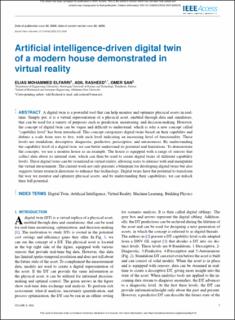| dc.description.abstract | A digital twin is a powerful tool that can help monitor and optimize physical assets in real-time. Simply put, it is a virtual representation of a physical asset, enabled through data and simulators, that can be used for a variety of purposes such as prediction, monitoring, and decision-making. However, the concept of digital twin can be vague and difficult to understand, which is why a new concept called "capability level" has been introduced. This concept categorizes digital twins based on their capability and defines a scale from zero to five, with each level indicating an increasing level of functionality. These levels are standalone, descriptive, diagnostic, predictive, prescriptive, and autonomous. By understanding the capability level of a digital twin, we can better understand its potential and limitations. To demonstrate the concepts, we use a modern house as an example. The house is equipped with a range of sensors that collect data about its internal state, which can then be used to create digital twins of different capability levels. These digital twins can be visualized in virtual reality, allowing users to interact with and manipulate the virtual environment. The current work not only presents a blueprint for developing digital twins but also suggests future research directions to enhance this technology. Digital twins have the potential to transform the way we monitor and optimize physical assets, and by understanding their capabilities, we can unlock their full potential. | en_US |

